5 Best Ways to Compress GIF Images Without Losing Quality
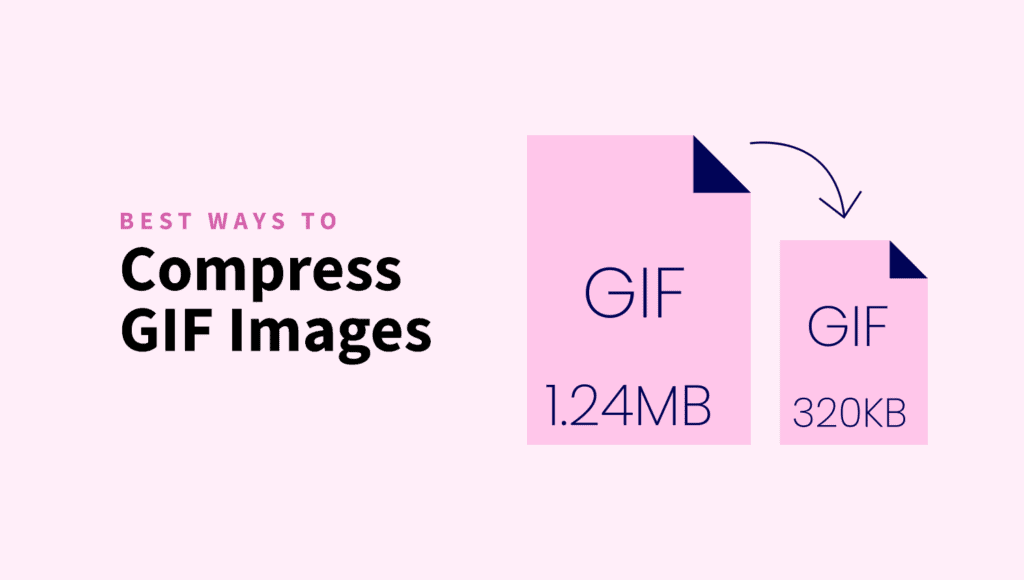
An image says a thousand words. But if you need more to speak, a GIF image is what you need!
But, GIF images can often give some trouble since they come in larger sizes.
Fortunately, you can easily solve this issue by using a GIF file size reducer.
Compressing GIF images is not as scary as we think. Thanks to the excellently engineered architecture of the GIF images.
In this article, we will discuss 5 super efficient yet simple methods to compress GIF images without losing quality.
Quick Takeaways
- GIF images are widely used for animations and reactions but can often have large file sizes. This can slow down website loading times.
- Compression helps by reducing the file size while maintaining image quality.
- Online tools like ShortPixel can easily compress GIFs.
- Reducing duplicate frames and optimizing transparency can further shrink file sizes without sacrificing animation quality.
- Choose the appropriate compression level to balance file size and quality.
What is a GIF Image?
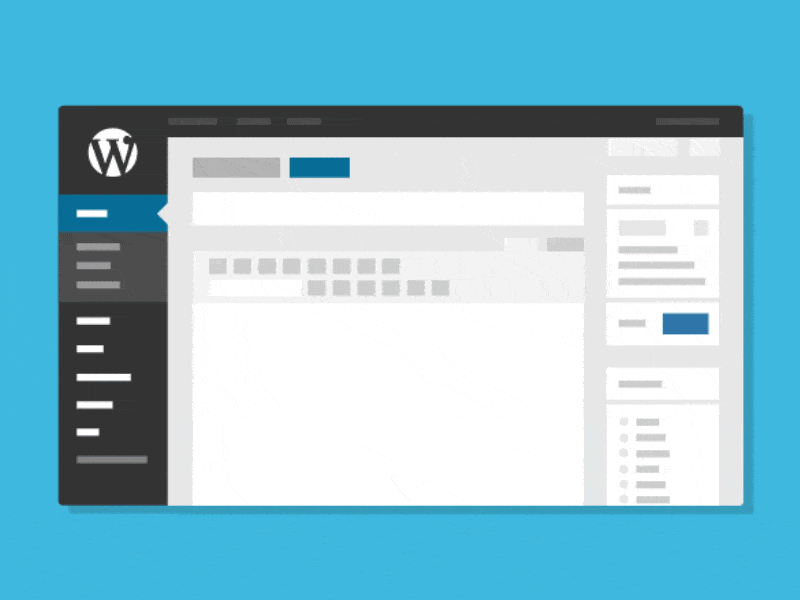
A GIF (Graphics Interchange Format) image is a widely used and versatile image format. It’s famous for its ability to show animations and reactions.
GIFs are usually short, silent video clips that play repeatedly. It makes your website excellent, expressing emotions or showing simple tutorials.
GIF images support transparency, which means they can have no background or overlay on top of other content. So, they take less storage.
You can use GIF images as your website logos, illustrating step-by-step guides and creating humorous memes.
GIF images have limitations, such as lower resolution and frame rates than videos, small file sizes, ease of use, and engagement factors. These characteristics keep GIF images famous for online communication and content creation.
Why should you compress GIF images?
Before going to that part, why do you use GIF images?
Display some short videos and instructions that eventually boost the visual appeal of your website.
But there’s a catch. Though GIF images are smaller than videos, GIF image files are usually bigger than regular images. And if a GIF image file is large, it takes more time to load.
The result?
Your website loads slower. It may cause more people to leave your site quickly, which could be better. Well, it hurts your website’s performance.
So, what’s the fix?
You can use a GIF size reducer to compress GIF images, shrinking their file size while maintaining quality.
Google says that about 25% of websites can save more than 250KB by compressing images and text. For some, it’s even more than 1MB. It’s a simple way to make your site faster and better.
How to compress GIF images?
GIF is a modern image format. You might think that it’s not very easy to compress GIF without losing quality. However, how to compress a GIF is simpler than it seems. Though GIFs are animated images, they compress quite like regular images.
Here are 5 of the most simple methods to downsize GIF images:
Use online GIF compression tools to compress GIF images
Compressing GIF images is unique because it reduces the number of image frames, colors used, and other elements. However, online GIF image compression tools can take care of all these aspects. With these tools, you can compress GIFs with just one click without losing quality.
Using a GIF compress tool will help you reduce GIF file size, making the GIFs load faster without compromising quality. Here is our list of the most effective tools:
ShortPixel
ShortPixel has an excellent image compression tool to optimize GIF images. It allows you to choose from three compression levels: Lossy, Glossy, and Lossless. Besides, you can preview the compressed image and compare it with the original and compressed versions.
Compress GIF images online for free!
Optimize your GIF files online effortlessly using the best image compressor.
Ezgif
Ezgif is a dedicated tool that is mainly made to compress GIF images. It offers options for lossy compression and allows you to select the compression level. You can also reduce the number of colors and frames and optimize image transparency.
FreeConvert
FreeConvert is a versatile tool to compress GIF images effortlessly. It provides advanced GIF compression features. It allows you to custom-set the compression level, reduce frames and colors, and configure the number of colors.
XConvert
XConvert has another tool you can use to compress GIF size. It lets you choose the compression level based on image quality, resize compressed GIF images, and remove colors and frames.
GIF Optimizer from Pi7 is an effective tool to compress GIF images effortlessly. It uses lossy compression and offers three levels of compression: low, medium, and high. You can reduce colors and frames and even add delay to removed frames.
These online tools can compress GIF file quickly and efficiently, ensuring your images remain visually appealing while reducing file sizes.
Pick a suitable image compression level
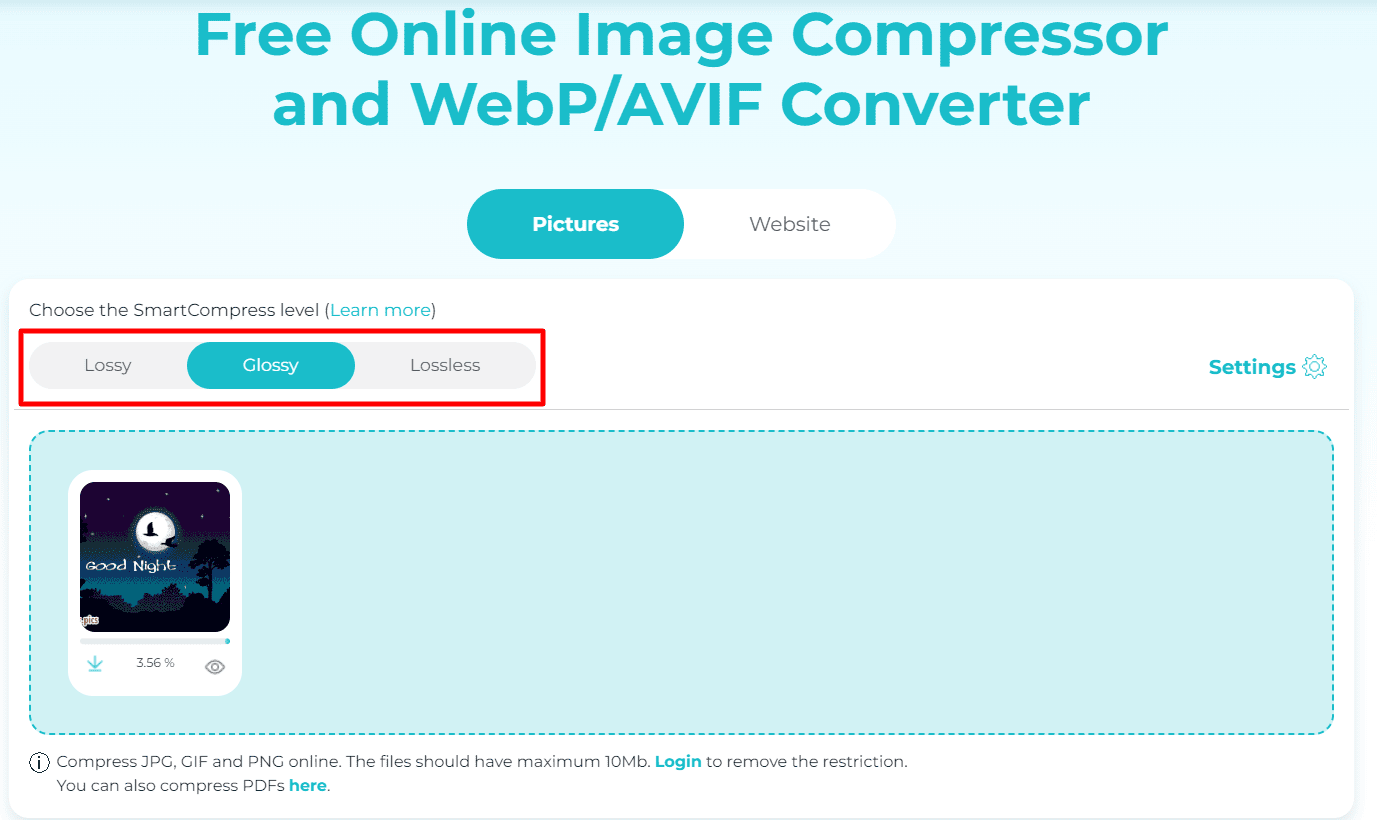
What’s the most critical factor in image compression?
It’s the compression level.
The compression level has a direct impact on image quality and file size. It also influences color reduction, frame rate, transparency, and more.
You can achieve the desired compression results without sacrificing image quality by selecting the appropriate compression level. Setting a compression level for GIF images is simple since most image compression tools offer this option.
With ShortPixel’s online image compression tool, it’s a piece of cake. Just upload your GIF image, pick a compression level (Lossy, Glossy, or Lossless), and let it do the work.
If you’re aiming for the smallest possible GIF file size, go for Lossy. If you want to reduce file size while preserving image quality, opt for Lossless.
Remove duplicate image frames
Animated GIF images are a collaboration of several image frames. GIF images store each frame as a separate image. The more frames there are, the larger the file size will be. Sometimes, these frames are identical.
Thus, it creates unnecessary redundancy. Removing duplicate frames can compress the GIF size of images effectively. It reduces the file size without significantly affecting the visual quality or elements.
Duplicate frames contain redundant image data. By removing these duplicates, you eliminate the need to store the same image information multiple times in the GIF file. This reduction in data can result in a smaller file size.

But you should know that reducing frames could impact the GIF’s visual quality. That’s why you should remove duplicate frames carefully.
Another thing you should remember is that when you remove duplicate frames, you may need to adjust the frame delay for the remaining structures to maintain the animation’s timing and flow.
You can use photo editing tools like Photoshop to remove GIFs’ duplicate frames. Also, you can use GIF compression online tools such as OnlineGIFTools or FreeConverter’s GIF Compressor to remove GIF frames.
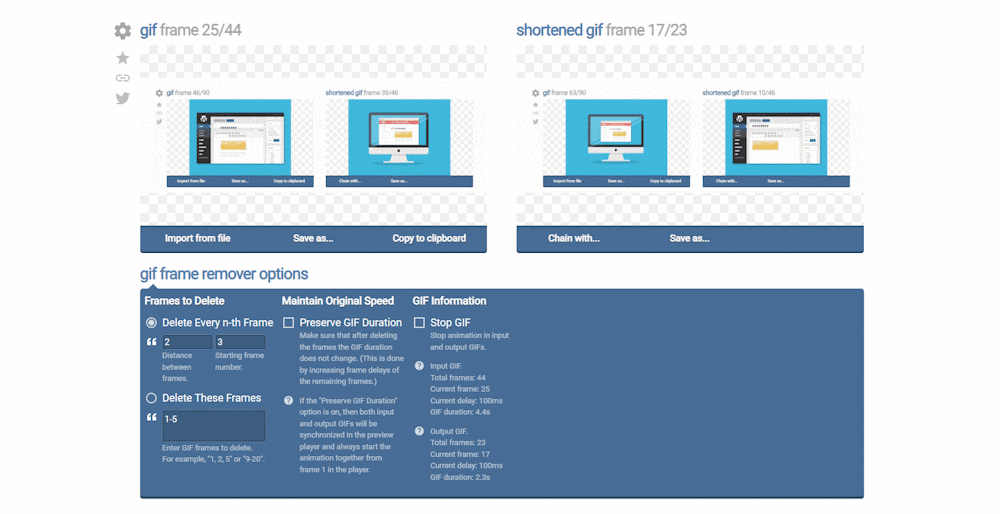
Just upload the GIF to the GIF Compressor, then scroll to the GIF Frame Remover Options.
Next, select removes duplicate frames from the Delete Every n-th Frame option or select Delect These Frames. You can also maintain the original speed from the options.
Reduce the number of colors
The number of colors in a GIF image affects its file size. The more colors used, the larger the file size will be. Thus, the color reduction technique becomes vital in compressing GIF images. It reduces the weight of the GIF images by reducing the number of colors.
GIF images are limited to a maximum of 256 colors (8-bit color palette). If you want to reduce size of GIF files, you can achieve this by lowering the number of colors.
However, you should reduce color carefully as it can cause a loss of color balance. It may be noticeable in the image, mainly if it contains gradients, subtle color transitions, or complex color patterns.
Color reduction also leads to loss of color quality. To mitigate the loss of color quality, you can apply dithering, which simulates additional colors by arranging the available colors in patterns. With a limited color palette, it can give the impression of more colors.
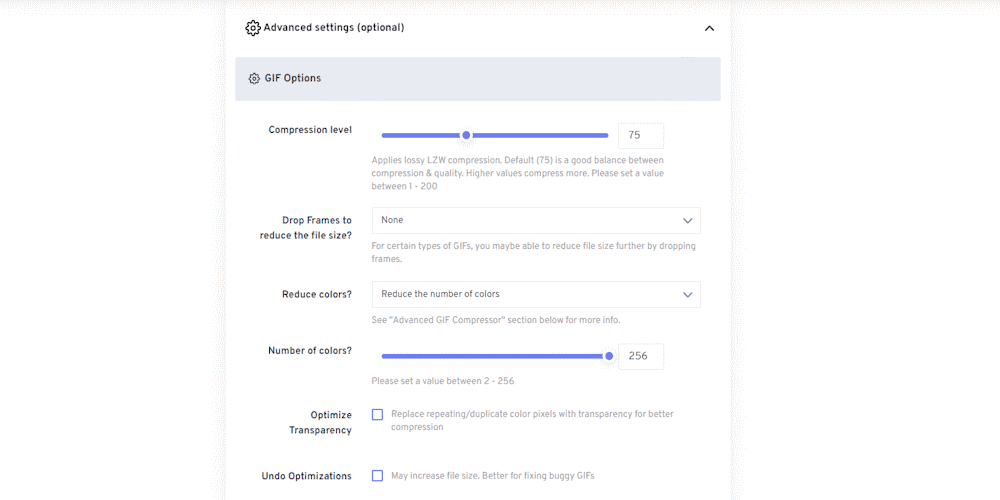
You can use FreeConverter’s GIF Compressor to reduce GIF’s color while compressing. To do that:
- Before you upload the GIF to the compressor, scroll down to Advanced Settings.
- Click on the Advanced Setting and choose Reduce the Number of Colors from the Reduce Colors? option.
- Reduce colors from the number of colors option.
- Click on the Apply setting and compress the GIF.
Optimize transparency in GIF images
GIF images store transparency information for each pixel, which can take up additional space in the file. Transparency optimization in a GIF image can reduce the file size by improving the efficiency of transparency information storage.
GIF images can have transparency in the form of an alpha channel that defines which pixels are transparent, partially transparent, or opaque. Optimizing this can lead to a lower GIF size without sacrificing image quality.
When optimizing transparency, you can use photo editing software such as Photoshop. Also, you can use online GIF compression tools such as FreeConverter’s GIF Compressor.
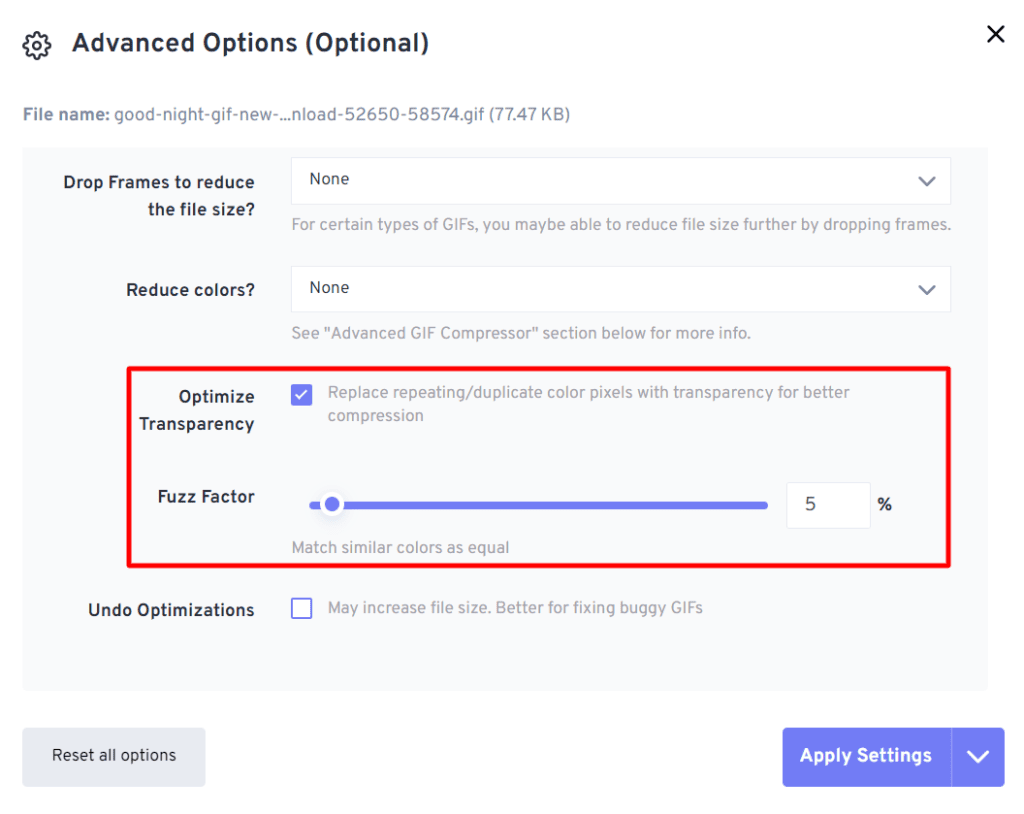
To optimize transparency using FreeConverter’s GIF Compressor:
- Upload the GIF to the GIF Compressor.
- Click on the Advanced setting and tick mark the Optimize Transparency.
- Use the Fuzz Factor settings to match “similar” colors.
- Click on the Apply setting and compress the GIF.
Summary
The primary purpose of using GIF images on your website is to gain the attention of your users. Serve them something eye-soothing and attractive.
You need to compress the images up to a level where your users remain happy and satisfied with the content you are providing them.
So, compress GIF images up to a certain level that balances both quality and weight. So, the GIF image remains attractive, and it loads immediately.
Compress all your GIF images online for free!
Tired of heavy files? Compress your GIF files online effortlessly with ShortPixel.
FAQs
How can I reduce the size of my GIF?
You have several options to reduce the size of your GIF. First, try reducing the number of colors, as GIFs are limited to 256 colors. Reducing the color count can significantly shrink file size without a big quality loss. Resizing the dimensions is another effective approach, since smaller dimensions mean less data. Adjusting the frame rate by reducing the number of frames per second can also help, as fewer frames mean a smaller file. For easy optimization, you can use ShortPixel’s online compression tool, which is great for quickly compressing GIFs and other image types without needing extra software. Additionally, consider removing any unnecessary frames or using programs like Photoshop, GIMP, or other online GIF compressors to refine the settings.
Does GIF compress images?
GIF itself is a type of image format that uses lossless compression, which means it reduces file size without losing any image data. However, GIFs are limited to a 256-color palette, which can sometimes result in larger file sizes for images with more colors or details. While GIFs can be compressed using algorithms, the compression is typically less efficient than other formats like PNG or JPEG, especially for photos or highly detailed images. If you’re looking to reduce the size of a GIF, you can use tools like ShortPixel’s online compression tool to optimize the GIF without sacrificing quality.
How can I compress a GIF online for free?
To compress a GIF online for free, you can use a tool like ShortPixel’s online compression tool. This tool lets you upload your GIF, optimize it, and reduce the file size without needing any software. Other popular options include EZGIF, which offers various settings for GIF compression, such as reducing colors, resizing dimensions, and adjusting frame rates. These tools are straightforward, allowing you to quickly decrease GIF size without any costs.
How to reduce GIF size for email?
To reduce a GIF’s size for email, start by resizing the GIF’s dimensions; smaller dimensions make it easier to send. You can also reduce the number of colors to lower the file size while keeping the quality suitable for viewing. Adjusting the frame rate, so there are fewer frames per second, is another effective way to make GIF smaller file size without losing the animation’s essence. Additionally, removing unnecessary frames helps cut down the file size. For a quick, effective solution, use ShortPixel’s online compression tool, which optimizes GIFs and makes them more email-friendly.
Can you compress GIFs without losing quality?
Yes, you can compress GIFs without losing quality, thanks to lossless compression methods. These methods reduce the file size while preserving the original image data, meaning the visual quality stays the same. Tools like ShortPixel’s online compressor make them smaller without sacrificing their appearance. However, keep in mind that highly detailed GIFs or those with many frames may still see some reduction in quality when heavily compressed, even with lossless methods.
How does GIF compression work?
GIF compression reduces the data in the image file while keeping the visual content intact. It uses lossless compression, meaning the original image quality remains the same. The compression process focuses on reducing the number of colors used in the GIF (limited to 256 colors) and removing redundant information, like identical pixels or unnecessary frames. Compression tools analyze the GIF and apply algorithms to optimize the file size without affecting the animation or quality noticeably.
How to optimize a GIF?
To optimize a GIF, start by reducing the number of colors it uses. Since GIFs are limited to 256 colors, using fewer colors can significantly reduce the file size without losing much quality. Another approach is to resize the dimensions of the GIF. Smaller dimensions naturally result in a lighter file. Reducing the frame rate is also useful; fewer frames per second can help compress the GIF while still maintaining smooth animation. Removing any unnecessary frames can further shrink the file. Additionally, you can use compression tools like ShortPixel’s online compression tool to optimize the GIF without compromising on quality.
How much do GIFs compress?
The amount a GIF can compress depends on its original size, complexity, and the methods used. In general, GIFs can be compressed anywhere from 30% to 70% without losing quality. The more colors, frames, and details the GIF has, the less it will compress efficiently. Simpler, smaller GIFs with fewer frames and colors typically compress more effectively. Using compression tools can help reduce file size GIF files while preserving as much quality as possible.